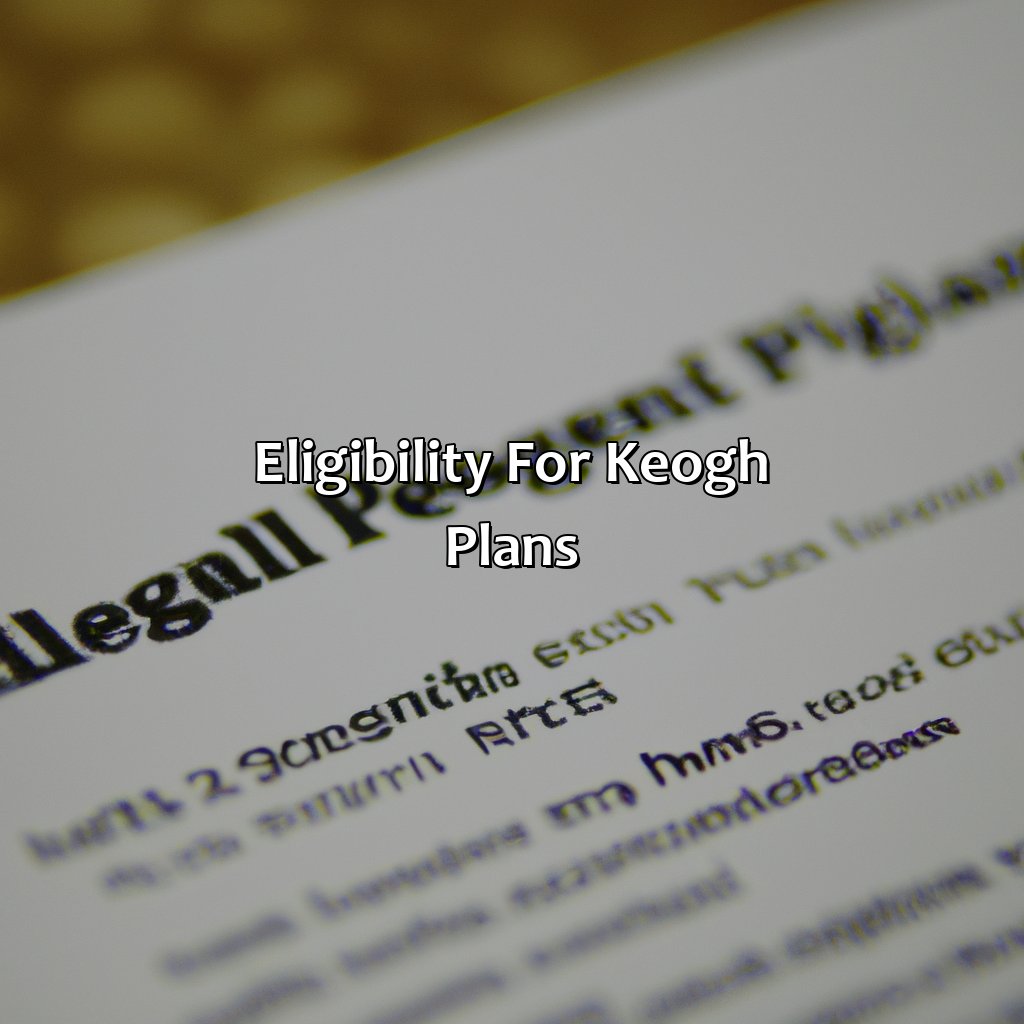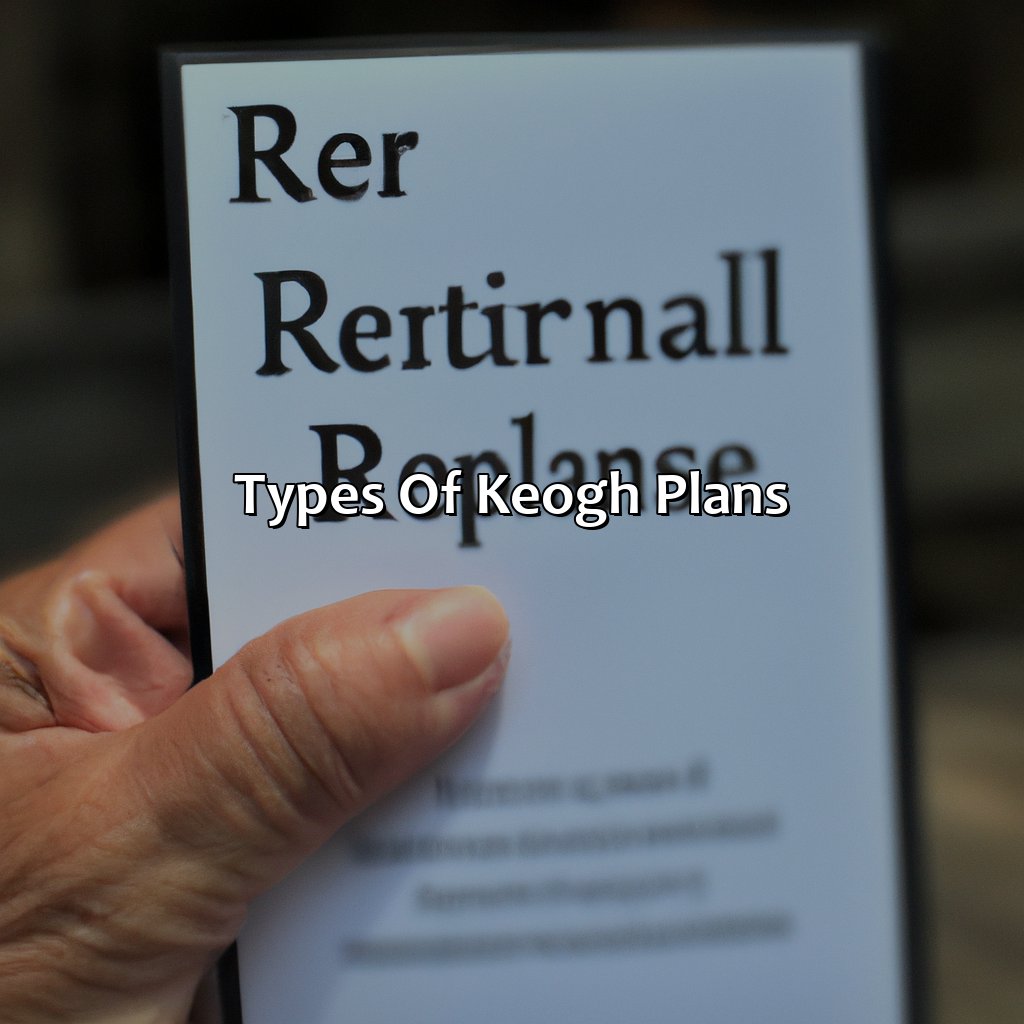Who Were Keogh Plans Designed To Provide Pension Benefits For?
Key Takeaway:
- Keogh plans were designed to provide pension benefits for self-employed individuals, small business owners, partnerships and sole proprietorships.
- Keogh plans offer tax benefits, higher contribution limits, and flexibility in plan design, making them an attractive option for retirement savings.
- There are three types of Keogh plans: profit-sharing plans, defined benefit plans and money purchase plans, each with its own contribution and distribution rules.
Tired of worrying about your retirement security? You’re not alone. Keogh plans are an overlooked pension benefit that can help provide financial stability and peace of mind. Learn how they work and how they can help you plan for retirement.
Eligibility for Keogh Plans
Eligibility for Keogh Retirement Plans
Self-employed individuals or those who own a small business can opt for Keogh plans to secure their retirement years. These plans are available to both employers and employees as long as they meet certain criteria. An eligible employer must have the necessary income from self-employment while eligible employees include those who are at least 21 years old, have worked for the employer for a minimum of one year and have worked for a minimum of 1,000 hours during that year.
Keogh retirement plans offer a tax-advantaged way to secure retirement savings. They provide flexible contribution limits, unlike other retirement plans, and offer participants the ability to customize their retirement savings to meet individual needs. It is important to note that contributions to Keogh plans are considered deductible business expenses for employers, reducing their taxable income.
One unique feature of Keogh plans is that they offer both defined benefit and defined contribution options. Self-employed individuals can set aside money either as a percentage of their income or a fixed dollar amount. For small business owners, contributions to Keogh plans can vary from year to year, which makes it a flexible option for business owners with fluctuating incomes.
To maximize the benefits of Keogh plans, it is important to assess individual financial goals and investment strategies. It is recommended to work with a financial planner to determine the right balance of contributions and investment opportunities. By carefully structuring contributions, an individual or business can take full advantage of Keogh plans’ versatility and tax benefits to secure a comfortable retirement.

Image credits: retiregenz.com by David Arnold
Self-Employed Individuals
Individuals who run their businesses without being a part of an organization can avail of the benefits of Keogh plans. These plans provide retirement and pension solutions for self-employed individuals to secure their future. Furthermore, these plans were introduced in 1962 by Eugene Keogh, a congressman from New York, to allow the self-employed to take advantage of pension plans similar to those offered by corporations.
A Keogh plan enables individuals to save money on taxes and invest it in their retirement living using pre-tax dollars. Additionally, two types of Keogh plans exist: defined contribution and defined benefit plans with varying rules and regulations that cater to different needs of self-employed individuals. Both types are eligible for tax-deductible contributions up to a certain amount with distinct contribution limits.
Moreover, setting up a Keogh plan is a straightforward process as compared to other complicated pension plans options available in the market; hence it is suitable for small business owners as well. The main benefit is that they are permitted more flexibility in terms of contributions and capital gains allowed within the plan.
It is said that back in 1962 when there were no legal provisions available for self-employed individuals concerning retirement savings or pension benefits; Eugene James Keogh introduced this scheme as a solution to address this gap. He reasoned that since self-employment did not entitle them to corporate-backed pensions, there should be something out there that offers similar partial government-backed support for them.
\nTo learn more about different types of pension plans, visit our website.
Small business owners may not always get the recognition they deserve, but at least they can get some retirement benefits with a Keogh plan.
Small Business Owners
Individuals with ownership interests in small enterprises are eligible for Keogh plans, which were created to provide pension benefits for self-employed professionals and business owners. These plans are designed to offer an alternative to traditional retirement savings options and allow contributors to defer taxes on contributions until they withdraw funds during retirement. In addition, Keogh plans provide flexibility and customization options, allowing individuals to tailor their investment strategy to meet their specific needs. Therefore, small business owners should consider the benefits of a Keogh plan when planning for their retirement. Failure to do so could result in missing out on significant financial opportunities later in life.
If you’re a sole proprietor or in a partnership, Keogh plans are like a retirement party invitation that you actually want to RSVP to.
Partnerships and Sole Proprietorships
For entities such as independent business owners and groups made up of multiple individuals, Keogh plans were designed. These plans were created to provide them with pension benefits that would allow them to continue receiving a steady income once they reached retirement age.
Sole proprietors are eligible for the Keogh plan if they have self-employment income. A partnership can also be eligible, but only if it is established via an agreement in writing or implicitly via activity.
Included in the eligibility list are owners of partnerships and sole proprietorship businesses. Such agreements entail an arrangement either in or out of writing.
A study by The American College found that less than 20% of small business owners from the ages of 45 to 50 years utilized any form of retirement plan, including the Keogh Plan designed to provide pension benefits for self-employed individuals.
Keogh Plans: because who needs a social life when you can retire in comfort and style?
Benefits of Keogh Plans
Introducing this section to explore the advantages of Keogh Plans! Tax benefits, higher contribution limits and flexibility. All bringing financial relief. Let’s find out how Keogh Plans offer these great benefits!

Image credits: retiregenz.com by Harry Duncun
Tax Benefits
Keogh Plans provide substantial tax benefits that allow business owners and self-employed individuals to save for retirement. The contributions made towards Keogh plans are tax-deductible, which reduces the taxable income of the contributor. Additionally, the earnings in the account grow on a tax-deferred basis, meaning that taxes are not paid on these earnings until they are withdrawn during retirement.
Moreover, Keogh plans offer higher contribution limits than other types of retirement accounts like IRAs or 401(k)s, allowing contributors to save more money tax-free. The limit varies based on the type of Keogh plan chosen and is calculated as a percentage of earned income.
It is important to note that Keogh plans were designed specifically for self-employed individuals or small business owners with no full-time employees. These plans offer tremendous benefits and help individuals secure their future and financial stability after retirement. If you are wondering which employees are most likely to have pension plans, Keogh plans may be more beneficial for self-employed or small business owners.
Considering the numerous advantages offered by Keogh Plans, it would be wise for self-employed individuals or small business owners to assess their financial status and opt for this plan while considering other options available. Don’t miss out on the opportunity to secure your future financially through such an effective method!
Want to save more for retirement? Keogh Plans have got you covered… as long as you’re not planning on retiring in Tahiti.
Higher Contribution Limits
Keogh Plans – Boosting Savings via Enhanced Limits
Keogh Plans, designed to offer self-employed individuals and unincorporated businesses the chance to save for retirement, provides beneficiaries with an array of benefits. One such benefit is associated with keenly set contribution limits that stand higher than those accessible through traditional retirement plans.
Below are three distinct points highlighting the advantages of Keogh Plans’ Higher Contribution Limits:
- Substantial Advantage: The biggest advantage intended by Keogh Plans’ higher contribution limits is that it allows plan participants to save substantial amounts for their future retirements.
- More tax Benefits: The Internal Revenue Service (IRS) enables qualified participants in Keogh Plans to diminish the amount of taxable incomes with more significant deductibles that reflect their contributions made to the plan.
- Maximum Contributions: Based on the structure of their businesses, self-employed individuals may choose from two distinct types of Keogh plans, which offer varying payment limits based on one’s salary or net profits, respectively. Furthermore, specific stipulations permit businesses that use both plans to maximize deductions by increasing their contributions simultaneously.
It must be noted that while there are different kinds of retirement plans available today that provide savings opportunity for owners and employees alike, the contribution limits assigned to these options rarely surpasses those offered by 401(k) and Roth IRAs.
Keogh plans can be your salvation. Don’t miss out on this fantastic opportunity- start saving as early as possible, and keep abreast with updated regulations governing this especially created pension scheme!
Flexibility is key with Keogh Plans – it’s like a yoga class for your retirement savings.
Flexibility
Keogh plans offer versatile options to customize retirement savings. These plans allow for substantial contributions, and individuals can choose the type of investment. Moreover, they permit flexibility in terms of their contribution schedule, making it easier for self-employed individuals to adjust their contributions based on income fluctuations.
Furthermore, Keogh plans provide various investment options like stocks and bonds. People can have more than one plan simultaneously with different contribution levels and investments. It provides enhanced opportunities to maximize the savings and prepare for a comfortable retirement.
Keogh plans are eligible only for those who are self-employed or own an unincorporated business. The company must be set up as a sole proprietorship, partnership, or LLC with at least 10% of the compensation declared as earned income.
Pro Tip: Maximize your tax benefits by utilizing the potential of Keogh Plans as better you save now; more secure will be your future.
Keogh Plans come in more types than a box of assorted chocolates, and each one will satisfy your retirement sweet tooth in a different way.
Types of Keogh Plans
Find out which Keogh plan is right for you and your biz! Check out the benefits of Profit-Sharing Plans, Defined Benefit Plans, and Money Purchase Plans. Each one has its own advantages and difficulties. Pinpoint the Keogh plan that best aligns with your retirement plans and financial situation.

Image credits: retiregenz.com by Harry Woodhock
Profit-Sharing Plans
- Contributions are typically made by the employer
- Employees can participate based on designated eligibility requirements
- Distributions can be lump-sum or periodic
- Plans can include vesting schedules to ensure employees stay with the company long-term
- Employers have flexibility in determining the amount and timing of distributions
It is important to note that Profit-Sharing Plans are subject to government regulations and must meet certain requirements to maintain their tax-advantaged status.
A report by Fidelity Investments found that 66% of small business owners who offer retirement benefits utilize Profit-Sharing Plans as part of their overall retirement strategy.
Defined Benefit Plans – because who wouldn’t want to trust their retirement income to a company who couldn’t even define their own plan?
Defined Benefit Plans
One form of retirement savings plans that provide a predetermined payout to beneficiaries, primarily in the form of lifetime annuities, is known as Guaranteed Benefit Plans. These types of pension plans are underwritten by the employer and guarantee a set level of benefits at retirement based on specific criteria such as age, salary, or years of service. In this case, the employer takes on the investment risk to ensure that funds are available to cover all future plan obligations.
Guaranteed Benefit Plans differ from other defined contribution plans like 401(k) and Keogh plans because they offer a fixed payout regardless of fluctuations in market performance. The actual amount received by employees depends on various factors such as length of service with the company or their salary history. While these plans may be more beneficial for those with long-term commitment to a single employer, changes in job status or career path could create uncertain outcomes in retirement payouts.
Historically, defined benefit pensions were common for public employees and union workers since non-governmental employers shifted towards defined contribution strategies in recent decades. Overall, Guaranteed Benefit Plans are considered valuable since they provide peace-of-mind through gifting stable retirement income.
Money can’t buy happiness, but it can buy you a money purchase plan – which is kind of the same thing.
Money Purchase Plans
Keogh plans designed for retirement benefits come in different types. An investment plan that can help self-employed or small business owners as an alternative to individual or group retirement plans is Money Purchase Plan. It’s a tax-deferred plan; the funds contributed are invested by an investment firm on behalf of the business and deposited into an account managed by the employer.
A Money Purchase Plan has some unique key features; for instance, employers determine beforehand how much they will contribute annually to their employees’ accounts. Employees can’t contribute personally, and the contributions made must be done every year until employees retire or leave the company entirely. These contributions are mandatory, so businesses must ensure they have adequate cash flow to meet their obligation each year. Learn more about pension schemes and who Keogh plans were designed to provide pension benefits for.
It’s essential for small businesses owners to consider various pension plans available in the market, which includes examining Keogh Plans like Profit-Sharing Plan, Defined Benefit Plan option, Contributions Only Plan e.t.c before choosing one most suitable.
One real-life story is that Paul’s Pizza was able to open multiple branches because of its profitability overtime with increased cash flow. The owner took a bold move by planning ahead and embracing a Money Purchase Plan as part of his incrementally growing employee benefits package for longevity reasons while keeping payment obligations low during less profitable months.
“I’m not great at math, but I can calculate one thing for sure – contributing to a Keogh Plan now means more happy hour drinks later.”
Administration and Contributions
Maximize your Keogh plan benefits by understanding its administration and contributions! There are two key factors – plan set-up and annual contributions.
This section titled “Administration and Contributions” will give you the info you need. It will provide solutions to help you manage and fund your Keogh retirement plan efficiently.

Image credits: retiregenz.com by Adam Duncun
Plan Set-Up
The establishment of Keogh plans, aimed at providing pension benefits, requires meticulous planning and strategic execution. Here’s a guide to set up the plan to ensure a steady stream of retirement income for the self-employed.
- Identify the Eligible Business – Only businesses with no employees other than the business owner and their spouse are eligible.
- Selecting a Plan Type – Self-employed individuals may choose between Defined Benefit or Defined Contribution plans that best fit their needs.
- Calculate Contributions – The contribution limits change annually, and it is crucial to enlist an expert’s help to avoid underfunding or overfunding.
- Filing Establishment Papers – The plan documents have to be filed and approved by IRS before the deadline
- Create an Investment Portfolio – Alongside setting up a tax-effective plan, creating an investment portfolio is necessary to achieve long-term financial goals
- Maintain Ongoing Compliance – Annual contributions must be made as prescribed by IRS rules, failing which the penalties could harmfully impact the financial stability in old age.
Keogh Plans offer several advantages such as flexible contribution limits and tax benefits. However, they also require supplementary paperwork compared to standard Individual Retirement Accounts (IRA).
A recent poll conducted amongst self-employed individuals revealed that over 75% didn’t know how much they would need post-retirement. A 45-year-old freelance writer, Josie Manuel shares her experience of mistakenly assuming that Social Security benefits would suffice for her after retirement. After consulting with a financial planner, she learned about Keogh Plans’ existence and set up one consistent with her personal finance goals.
Annual contributions are like gym memberships – committed to at the start of the year but often forgotten by February.
Annual Contributions
The amount you can contribute to a Keogh plan each year depends on various factors, including your compensation level and age. Here are the key points regarding annual contributions:
- The maximum contribution for 2021 is $58,000 or 100% of your income, whichever is less.
- If you’re over age 50, you can make an additional “catch-up” contribution of up to $6,500.
- Your contributions can’t exceed your net earnings from self-employment or the amount of income from the business sponsoring the plan.
- Unlike other types of retirement plans, there are no required minimum contributions each year.
- Contributions must be made by the employer’s tax-filing deadline, including extensions.
Notably, Keogh plans are often used by self-employed individuals and small business owners who want to save for retirement while also enjoying tax benefits.
Did you know that Keogh plans were named after Eugene Keogh, a US Representative who sponsored legislation allowing for tax-deferred pension savings for self-employed individuals?
You can take out your Keogh plan money whenever you want, but be prepared to face the wrath of the IRS like a toddler throwing a tantrum.
Withdrawals and Distributions
Learn ’bout Keogh Plans withdrawals and distributions. Look at the sub-sections. Early withdrawal penalties and required minimum distributions. Know the consequences of accessing funds early. Also, mandatory withdrawals when you hit a certain age.

Image credits: retiregenz.com by James Arnold
Early Withdrawal Penalties
When funds are accessed before reaching a certain age, there are financial consequences called Premature Withdrawal Penalties (PWP) within Keogh plans. PWP amount varies depending on account-holder’s age and tax positions. PWP is considered as impositions so it cutbacks the actual retirement investments.
Moreover, if the employee’s account is closed down due to death or disability, no penalty will be deducted, as PWP only applies in situations that the account holder decides to withdraw funds without meeting the mandatory age limits.
A unique point regarding Early Withdrawal Penalties is that Keogh plans emerged in 1962, primarily aimed at providing pension benefits for self-employed individuals such as sole proprietors and unincorporated businesses. Learn more about who introduced the pension system.
Nothing says ‘happy retirement’ like being forced to take money out of your IRA against your will.
Required Minimum Distributions
The smallest amount of funds that must be withdrawn from a retirement account each year to avoid penalties is known as Required Minimum Distribution or RMD. The RMD is applicable for individuals who reached age 70½ and those who have inherited an IRA or another qualified plan. The purpose of this regulation is to ensure that the money saved for retirement is not used solely for generational transfers.
An individual can calculate their RMD by dividing the prior year-end balance of their retirement plan by a life expectancy divisor. Depending on the type of account, RMDs can vary between different accounts, and taxes are applied if an individual fails to withdraw the specified minimum distribution on time. One exception to the rule applies to Keogh plans, which do not require a mandatory distribution until an individual reaches age 72.
It’s important to note exceptions regarding RMD qualifications and understand that planning your finances appropriately remains crucial for optimal utilization of your funds. A financial advisor can help you determine how much distribution is mandatory yet recommend strategic withdrawals to best meet your lifestyle needs.
Pro Tip: Receiving no profits does not cause exemption from taxing distributions in traditional IRAs or employer-sponsored plans.
Some Facts About Who Were Keogh Plans Designed to Provide Pension Benefits For:
- ✅ Keogh plans were designed to provide pension benefits for self-employed individuals and their employees. (Source: The Balance)
- ✅ Keogh plans were established by Congress in 1962. (Source: Investopedia)
- ✅ Keogh plans are similar to 401(k) plans and have similar contribution limits. (Source: IRS)
- ✅ Keogh plans are named after Eugene Keogh, a congressman who sponsored the legislation. (Source: Forbes)
- ✅ Keogh plans offer tax benefits and can provide retirement security for small business owners and their employees. (Source: Nolo)
FAQs about Who Were Keogh Plans Designed To Provide Pension Benefits For?
Who were Keogh plans designed to provide pension benefits for?
Keogh plans were designed to provide pension benefits for self-employed individuals or small businesses owners and their employees.
Are Keogh plans still in use today?
Yes, Keogh plans are still in use today, but they are now known as tax-deferred savings plans or qualified retirement plans.
What are the tax benefits of a Keogh plan?
Contributions to a Keogh plan are tax-deductible, reducing the individual’s taxable income. Additionally, the earnings on the contributions grow tax-free until withdrawal.
Can a self-employed individual contribute to a Keogh plan even if they have employees?
Yes, a self-employed individual with employees can contribute to a Keogh plan on their own behalf and on behalf of their employees.
What are the contribution limits for Keogh plans?
The contribution limits for Keogh plans depend on various factors such as age, income, and type of plan. For example, as of 2021, the maximum contribution limit for a defined contribution Keogh plan is $58,000.
What happens to a Keogh plan when the owner dies?
If the owner of a Keogh plan dies, the plan’s assets are typically transferred to the beneficiary designated by the owner. If no beneficiary is designated, the assets may be transferred to the owner’s estate.
